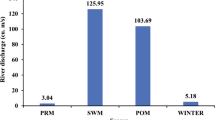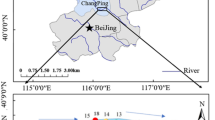Abstract
This paper describes the prevalence of indicator and pathogenic bacterial groups in water and sediments in OSZ—offshore, ISZ—inshore, IEZ—inner estuary, and UEZ—upper estuary along the river Chapora, central west coast of India, which is influenced by anthropogenic inputs. The abundance of indicator bacterial groups such as total coliforms and Escherichia coli–like organisms in water ranged from non-detectable (ND) to 103 colony-forming units (CFU)/mL. In contrast, their abundance in the sediments was six orders magnitude higher than water (ND to 109 CFU/g). The abundance of potential pathogenic bacteria in water and sediment samples ranged from ND to 103 CFU/mL and from ND to 109 CFU/g respectively, with Shigella-like organisms (SHLO) being the most abundant. In the surface waters, SHLO and Pseudomonas aeruginosa–like organisms (PALO) and in bottom waters, Vibrio parahaemolyticus–like organism and PALO increased progressively from OSZ to UEZ. In contrast, Proteus/Klebsiella-like organisms (PKLO) showed a reverse trend. Amongst all four zones, IEZ was the most contaminated in terms of the higher abundance of indicator and potential pathogenic bacterial populations as corroborated by significantly lower water quality index value. Principal component analysis performed using physico-chemical variables and bacterial groups to reduce data set variability revealed that a different set of parameters contributed differently to the total variation in each zone. Considering the eco-sensitivity of the river Chapora, the results of the present study call for precautionary measures to minimize the degree of anthropogenic inputs.




Similar content being viewed by others
Data availability
Not applicable
References
Alm, E. W., Burke, J., & Spain, A. (2003). Fecal indicator bacteria are abundant in wet sand at freshwater beaches. Water Research, 37(16), 3978–3982. https://doi.org/10.1016/S0043-1354(03)00301-4.
Ansari, Z. A., Chatterji, A., Ingole, B. S., Sreepada, R. A., Rivonkar, C. U., & Parulekar, A. H. (1995). Community structure and seasonal variation of an inshore demersal fish community at Goa, west coast of India. Estuarine, Coastal and Shelf Science, 41(5), 593–610. https://doi.org/10.1016/0272-7714(95)90029-2.
APHA. (1989). Standard methods for the examination of water and wastewater (17th ed.). Washington, D.C: American Public Health Association.
Baghel, V. S., Gopal, K., Dwivedi, S., & Tripathi, R. D. (2005). Bacterial indicators of faecal contamination of the Gangetic river system right at its source. Ecological Indicators, 5(1), 49–56. https://doi.org/10.1016/j.ecolind.2004.09.002.
Batabyal, P., Einsporn, M. H., Mookerjee, S., Palit, A., Neogi, S. B., Nair, G. B., & Lara, R. J. (2014). Influence of hydrologic and anthropogenic factors on the abundance variability of enteropathogens in the Ganges estuary, a cholera endemic region. Science of the Total Environment, 472, 154–161. https://doi.org/10.1016/j.scitotenv.2013.10.093.
Borade, S., Dhawde, R., Maloo, A., Gajbhiye, S. N., Ram, A., & Dastager, S. G. (2015). Assessment of enteric bacterial indicators and correlation with physico-chemical parameters in Veraval coast, India. Indian Journal of Geo-Marine Sciences, 44(4), 501–507 http://nopr.niscair.res.in/handle/123456789/34727.
Chandra, R., Singh, S., & Raj, A. (2006). Seasonal bacteriological analysis of Gola river water contaminated with pulp paper mill waste in Uttaranchal, India. Environmental Monitoring and Assessment, 118(1–3), 393–406. https://doi.org/10.1007/s10661-006-1508-4.
Clarke, K. R., & Warwick, R. M. (2001). Change in marine communities: an approach to statistical analysis and interpretation (2nd ed.). Plymouth: PRIMER-E.
Craig, D. L., Fallowfield, H. J., & Cromar, N. J. (2004). Use of microcosms to determine persistence of Escherichia coli in recreational coastal water and sediment and validation with in situ measurements. Journal of Applied Microbiology, 96(5), 922–930. https://doi.org/10.1111/j.1365-2672.2004.02243.x.
Dash, R. R., Prakash, E. B., Kumar, P., Mehrotra, I., Sandhu, C., & Grischek, T. (2010). River bank filtration in Haridwar, India: removal of turbidity, organics and bacteria. Hydrogeology Journal, 18(4), 973–983. https://doi.org/10.1007/s10040-010-0574-4.
EPA (Environmental Protection Agency) (1996). Quality criteria for waters, Washington, DC.
Fujioka, R. (2002). Microbial indicators of marine recreational water quality. In C. J. Hurst, R. L. Crawford, G. Knudsen, M. J. McIneney, & L. D. Stetzenbach (Eds.), Manual of environmental microbiology (2nd ed., pp. 234–243). Washington DC: American Society for Microbiology Press.
Hobbie, J. E., Daley, R. J., & Jasper, S. (1977). Use of nuclepore filters for counting bacteria by fluorescence microscopy. Applied Environmental Microbiology, 33(5), 1225–1228.
Jang, J., Hur, H. G., Sadowsky, M. J., Byappanahalli, M. N., Yan, T., & Ishii, S. (2017). Environmental Escherichia coli: ecology and public health implications-a review. Journal of Applied Microbiology, 123(3), 570–581. https://doi.org/10.1111/jam.13468.
Khandeparker, L., Anil, A. C., Naik, S. D., & Gaonkar, C. C. (2015). Daily variations in pathogenic bacterial populations in a monsoon influenced tropical environment. Marine Pollution Bulletin, 96(1–2), 337–343. https://doi.org/10.1016/j.marpolbul.2015.04.051.
Kumarasamy, P., Vignesh, S., Arthur James, R., Muthukumar, K., & Rajendran, A. (2009). Enumeration and identification of pathogenic pollution indicators in Cauvery, South India. Research Journal of Microbiology, 4(12), 540–549. https://doi.org/10.3923/jm.2009.540.549.
Liss, S. N., Droppo, I. G., Flannigan, D. T., & Leppard, G. G. (1996). Floc architecture in wastewater and natural riverine systems. Environmental Science & Technology, 30(2), 680–686. https://doi.org/10.1021/es950426r.
Luna, G. M., Vignaroli, C., Rinaldi, C., Pusceddu, A., Nicoletti, L., Gabellini, M., Danovaro, R., & Biavasco, F. (2010). Extraintestinal Escherichia coli carrying virulence genes in coastal marine sediments. Applied Environmental Microbiology, 76(17), 5659–5668. https://doi.org/10.1128/AEM.03138-09.
McLusky, D. S., & Elliott, M. (2004). The estuarine ecosystem: ecology, threats and management (3rd ed.). Oxford: Oxford University Press 216 pp.
Mishra, A., Mukherjee, A., & Tripathi, B. D. (2009). Seasonal and temporal variations in physico-chemical and bacteriological characteristics of River Ganga in Varanasi. International Journal of Environmental Research, 3(3), 395–402. https://doi.org/10.12944/CWE.2.2.08.
Mohandass, C., Nair, S., Achuthankutty, C. T., & Bharathi, P. A. (2000). Pollution monitoring of coastal and estuarine areas: I. Bacterial indicators along the south Gujarat coast. Indian Journal of Marine Sciences, 29, 43–47.
Nagvenkar, G. S., & Ramaiah, N. (2009). Abundance of sewage-pollution indicator and human pathogenic bacteria in a tropical estuarine complex. Environmental Monitoring and Assessment, 155(1–4), 245–256. https://doi.org/10.1007/s10661-008-0432-1.
Nybakken, J. W., & Bertness, M. D. (2005). Estuaries and salt marshes. In J. W. Nybakken & M. D. Bertness (Eds.), Marine biology: an ecological approach (Vol. 6, pp. 1–579). San Francisco: Pearson/Benjamin Cummings.
Odonkor, S. T., & Ampofo, J. K. (2013). Escherichia coli as an indicator of bacteriological quality of water: an overview. Microbiology Research, 4, 2. https://doi.org/10.4081/mr.2013.e2.
Oram, B. P. G. (2010). The water quality index. Water research Center. https://www.water-research.net/waterqualityindex/waterqualityindex.html Accessed 15 September 2018.
Ramaiah, N., Kenkre, V. D., & Verlecar, X. N. (2002). Marine environmental pollution stress detection through direct viable counts of bacteria. Water Research, 36(9), 2383–2393. https://doi.org/10.1016/s0043-1354(01)00435-3.
Ramaiah, N., Kolhe, V., & Sadhasivan, A. (2004). Abundance of pollution indicator and pathogenic bacteria in Mumbai waters. Current Science, 87(4), 435–439.
RRC. (2019). River Rejuvenation Committee (RRC), Goa. River Rejuvenation Action Plan-Chapora River. The River Rejuvenation Committee Government of Goa (India), 33 pp.
Sanap, R. R., Mohite, A. K., Pingle, S. D., & Gunale, V. R. (2006). Evaluation of water qualities of Godawari River with reference to physico-chemical parameters, Dist. Nasik (MS), India. Pollution Research, 25(4), 775.
Shenai-Tirodkar, P. S., Gauns, M. U., & Ansari, Z. A. (2016a). Evaluation of surface water and sediment quality in Chicalim Bay, Nerul Creek, and Chapora Bay from Goa coast, India– a statistical approach. Environmental Monitoring and Assessment, 188(8), 472. https://doi.org/10.1007/s10661-016-5445-6.
Shenai-Tirodkar, P. S., Gauns, M. U., & Ansari, Z. A. (2016b). Concentrations of heavy metals in commercially important oysters from Goa, central-west coast of India. Bulletin of Environmental Contamination and Toxicology, 97(6), 813–819. https://doi.org/10.1007/s00128-016-1956-7.
Snozzi, M., Ashbolt, N. J., & Grabow, W. O. K. (2001). Indicators of microbial water quality. In L. Fewtrell & J. Bartram (Eds.), Water quality guidelines, standards and health: assessment of risk and risk management for water-related infectious disease (pp. 289–316). London: IWA Publishing.
Strickland, J. D., & Parsons, T. R. (1972). A practical handbook of seawater analysis, Vol. 167, (2nd ed., pp. 310). Ottawa: Bulletin of the Fisheries Research Board of Canada.
Tallon, P., Magajna, B., Lofranco, C., & Leung, K. T. (2005). Microbial indicators of faecal contamination in water: a current perspective. Water, Air, and Soil Pollution, 166(1–4), 139–166. https://doi.org/10.1007/s11270-005-7905-4.
Yang, H. J., Shen, Z. M., Zhang, J. P., & Wang, W. H. (2007). Water quality characteristics along the course of the Huangpu River (China). Journal of Environmental Sciences, 19(10), 1193–1198. https://doi.org/10.1016/s1001-0742(07)60195-8.
Acknowledgements
Authors express their gratitude to the Director of the CSIR-National Institute of Oceanography (CSIR-NIO), Goa, for the research and analytical facilities provided for carrying out this work. This is CSIR-NIO contribution No.__6544__.
Code availability
Not applicable
Author information
Authors and Affiliations
Contributions
1) Nitisha Sangodkar—Conceptualization, Formal analysis, software analysis and writing original draft.
2) Maria Judith Gonsalves—conceptualization, supervision, review and editing.
3) Yogini Shanbhag—Formal analysis and writing original draft.
4) R.A. Sreepada—Conceptualization, supervision, review and editing.
5) Delcy Nazareth— Formal analysis and software analysis.
Corresponding author
Ethics declarations
Conflicts of interest
The authors declare that they have no conflict of interest.
Consent to participate
Not applicable
Ethics approval
Not applicable
Additional information
Publisher’s note
Springer Nature remains neutral with regard to jurisdictional claims in published maps and institutional affiliations.
Rights and permissions
About this article
Cite this article
Sangodkar, N., Gonsalves, M.J., Shanbhag, Y. et al. Prevalence of indicator and potential pathogenic bacterial groups in the Chapora bay-estuarine system, Goa, central west coast of India. Environ Monit Assess 192, 397 (2020). https://doi.org/10.1007/s10661-020-08368-1
Received:
Accepted:
Published:
DOI: https://doi.org/10.1007/s10661-020-08368-1




